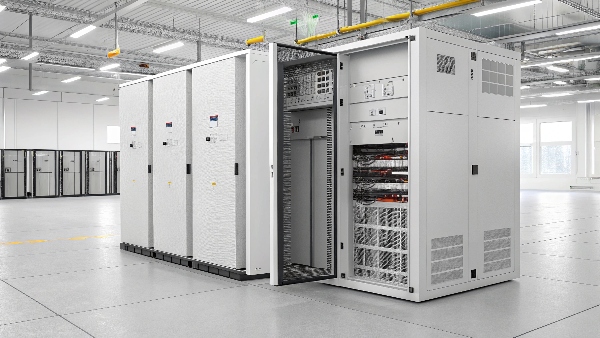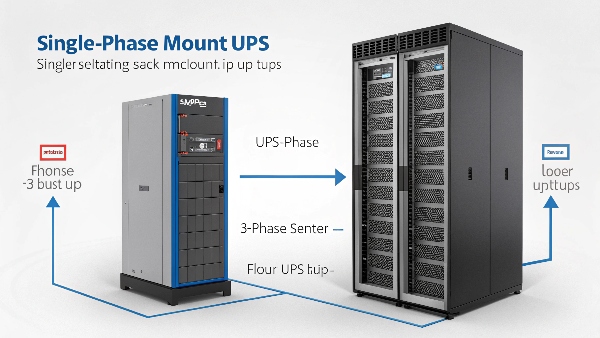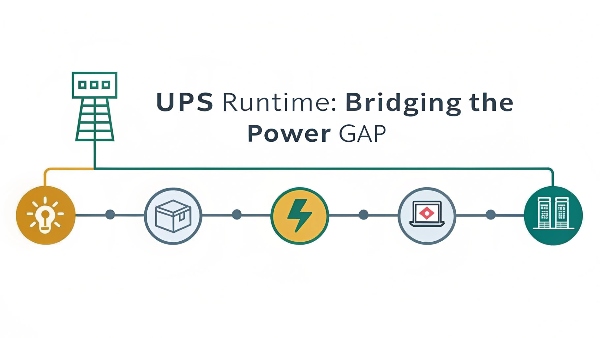Data centers and critical facilities demand immense, reliable power. Are 3-phase UPS systems the key to meeting these high-capacity needs and ensuring unwavering operational stability?
3-phase Uninterruptible Power Supplies (UPS) are vital for data centers and large facilities. They efficiently deliver high-capacity, clean power, ensuring continuous operation of critical IT loads and infrastructure during outages.

Transition Paragraph:
At Daopulse, our decade of OEM/ODM manufacturing experience has shown us firsthand the specific power demands of various environments. My core insight is that our company offers single-phase UPS systems, as well as three-phase UPS systems, for data center applications. This flexibility allows us to cater to a wide range of client needs, from smaller server rooms to large-scale data facilities. For a Procurement Manager like Mr. Li, tasked with sourcing reliable power for a hospital's data infrastructure, understanding the distinction and application of these UPS types is crucial for optimal system design and resilience.
What type of UPS do data centers use?
Given the diverse power needs, do data centers stick to one UPS type? Or do they employ a mix, and what dictates the choice for specific applications?
Data centers primarily use online double-conversion UPS systems for critical IT loads, often 3-phase for larger facilities and sometimes single-phase for smaller racks or specific equipment.

Dive deeper Paragraph:
Data centers, due to their critical nature and varying scales, utilize specific UPS topologies and configurations to meet their stringent power requirements. My insight that our company offers single-phase UPS systems, as well as three-phase UPS systems, for data center applications directly addresses this diverse need. The choice isn't arbitrary; it's driven by the load characteristics, capacity requirements, and the level of protection demanded.
The dominant type of UPS found in data centers for protecting critical IT equipment (servers, storage, network gear) is the Online Double-Conversion UPS. Here's why:
- Highest Level of Protection: This topology continuously converts incoming AC power to DC and then back to perfectly regulated AC, completely isolating the sensitive IT load from raw utility power. This means there's zero transfer time during an outage, and it protects against all common power problems (sags, surges, spikes, noise, frequency variations).
- Suitability for Sensitive Loads: Modern IT equipment is highly sensitive to power anomalies. Online UPS systems ensure a clean, stable sine wave output at all times.
Regarding phase configuration:
-
3-Phase UPS Systems: These are the workhorses for medium to large data centers and critical facilities.
- High Power Capacity1: 3-phase power is inherently more efficient for delivering large amounts of power (typically 20 kVA and above, often up to several Megawatts). Data halls with numerous server racks have substantial power demands that 3-phase systems are designed to handle.
- Balanced Loads: They help in balancing power loads across the three phases, which is often a requirement or preference for utility feeds and building electrical infrastructure.
- Efficiency at Scale2: For larger loads, 3-phase UPS units generally offer better operational efficiency.
At Daopulse, our patented technology development often focuses on enhancing the reliability and efficiency of these larger 3-phase units, using both lead-acid and advanced lithium battery solutions.
-
Single-Phase UPS Systems: While less common for the main data hall power, single-phase UPS units still have their place.
- Smaller Loads/Edge Deployments: Used for individual server racks, network closets, Point-of-Sale (POS) systems, or edge computing sites with lower power requirements (typically up to 20 kVA).
- Specific Equipment: Some specialized IT or facility equipment might be designed for single-phase input.
- Cost-Effectiveness for Smaller Needs: For smaller, isolated applications, a single-phase UPS can be a more economical choice.
Therefore, a large data center will typically feature a robust 3-phase online UPS infrastructure for its main IT loads, possibly supplemented by smaller single-phase UPS units for distributed IT or ancillary systems. Our ability to design and customize both ensures we can meet the specific voltage, capacity, and application needs for clients worldwide.
| UPS Characteristic | Predominant Choice in Data Centers | Rationale |
|---|---|---|
| Topology | Online Double-Conversion | Highest protection level, zero transfer time, conditions all power issues |
| Phase (Main IT Load) | 3-Phase | High power capacity, load balancing, efficiency for large loads (>20 kVA) |
| Phase (Smaller Loads) | Single-Phase | Suitable for individual racks, edge sites, specific equipment (<20 kVA) |
What is the primary function of UPS in a data centre?
Beyond just backup, what is the core mission of a UPS? What fundamental role does it play in the day-to-day, second-to-second operation of a data center's critical functions?
The primary function of a UPS in a data center is to provide instantaneous, conditioned power to critical IT loads during any utility power disruption, ensuring operational continuity and data integrity.

Dive deeper Paragraph:
The primary function of an Uninterruptible Power Supply (UPS) in a data center is profoundly singular yet multifaceted in its impact: to guarantee a continuous, clean, and stable supply of electrical power to the critical IT infrastructure, irrespective of the state of the incoming utility power. My entire career at Daopulse, specializing in UPS design and manufacturing, has centered on perfecting this primary function. My insight that our company offers single-phase UPS systems, as well as three-phase UPS systems, for data center applications stems from understanding how this core function must be delivered reliably, whether for a single rack or an entire data hall.
Let's break down this primary function into its key components:
- Instantaneous Power Backup: This is the most recognized role. When utility power fails completely (blackout) or drops significantly (sag/brownout), the UPS immediately switches to its internal batteries (whether lead-acid or lithium) to supply power to the connected load. This transition is seamless in online double-conversion systems, meaning the IT equipment experiences no interruption whatsoever. This battery bridge is crucial for riding out short outages or providing time for backup generators to start and take over the load.
- Power Conditioning: Utility power is rarely "perfect." It can be subject to various disturbances such as voltage spikes, electrical noise, frequency variations, and harmonic distortion. An online UPS continuously processes and regenerates the power, delivering a clean, precise, and stable sine wave to the sensitive IT equipment. This conditioning protects hardware from damage, reduces operational errors, and extends the lifespan of the connected devices. This is a vital, often overlooked, aspect of the UPS's primary function.
- Ensuring Operational Continuity: By providing backup and conditioned power, the UPS ensures that the data center's services—applications, data processing, network communications—continue to operate without interruption during most power events. This directly translates to business continuity, preventing costly downtime, lost revenue, and reputational damage.
- Protecting Data Integrity: Sudden power loss can lead to data corruption or loss, especially if systems are in the middle of write operations or transactions. The UPS ensures that systems either continue to run or have sufficient time for an orderly, graceful shutdown, preserving the integrity of valuable data.
Essentially, the UPS acts as a critical buffer and refiner between the potentially unstable utility grid and the highly sensitive, mission-critical IT load. It's the first line of defense, ensuring that the digital heart of an organization keeps beating.
Why are UPS systems critical for data center operations?
We know they provide power, but what makes them indispensable? Why can't a data center simply rely on the grid and generators without this intermediary protective layer?
UPS systems are critical because they offer zero-millisecond failover to battery power and continuous power conditioning, which generators alone cannot provide, preventing data loss, hardware damage, and costly service interruptions.

Dive deeper Paragraph:
The criticality of Uninterruptible Power Supply (UPS) systems for data center operations stems from their unique ability to provide immediate, clean power—a capability that no other component in the power chain, including backup generators, can replicate with the same speed and quality. My experience at Daopulse, where we develop patented UPS technology and ensure compliance with CE, RoHS, and ISO standards, constantly reinforces this. My insight that our company offers single-phase UPS systems, as well as three-phase UPS systems, for data center applications highlights our commitment to providing this critical protection across all scales.
Here's a breakdown of why UPS systems are non-negotiable:
- Instantaneous Response (Zero Transfer Time): This is paramount. When utility power falters or fails, an online double-conversion UPS provides a seamless, zero-millisecond transfer to battery power. IT equipment doesn't even register the switch. Generators, on the other hand, require time (seconds to over a minute) to detect an outage, start up, and stabilize their output. Without a UPS to bridge this gap, critical systems would crash.
- Continuous Power Conditioning: Utility power is often "dirty," containing sags, surges, spikes, electrical noise, and frequency variations. These anomalies can stress, damage, or cause erratic behavior in sensitive IT equipment. A UPS (especially online types) constantly conditions this power, delivering a clean, stable waveform, thus protecting hardware investments and ensuring reliable operation. Generators alone do not provide this level of continuous conditioning.
- Protection Against Micro-Outages and Fluctuations: Many power disturbances are very short-lived—flickers or brief sags that might not even be long enough to trigger a generator start sequence. However, these are more than sufficient to disrupt IT loads. A UPS handles these common, minor events effortlessly, preventing frequent system reboots or instability.
- Ensuring Orderly Shutdown During Extended Outages: If a utility outage is prolonged and generators fail or run out of fuel, the UPS provides a finite window of battery runtime. This allows for automated or manual graceful shutdown procedures to be initiated, preventing data corruption and chaotic system crashes.
- Overall System Reliability and Uptime: The combination of instantaneous backup and continuous power conditioning significantly enhances the overall reliability and uptime of the data center. For businesses, this translates directly to maintaining service level agreements (SLAs), customer satisfaction, and revenue streams.
In essence, while generators are crucial for long-term outage support, the UPS is the critical first responder, providing the immediate, high-quality power essential for the delicate and continuous operation of modern data centers. Attempting to operate a data center without a robust UPS strategy is an unacceptable risk.
| Feature | UPS (Online Double-Conversion) | Backup Generator Alone |
|---|---|---|
| Transfer Time to Backup | Zero (instantaneous) | Seconds to over a minute |
| Power Conditioning | Continuous, comprehensive | Minimal to none (output can fluctuate) |
| Protection from Sags/Surges | Excellent | Limited |
| Handling Micro-Outages | Seamlessly bridges | May not even start for short events |
| Output Power Quality | Highly stable, clean sine wave | Can vary, may require further conditioning |
How long should a data center UPS last?
Is UPS battery runtime about minutes or hours? What's the strategic thinking behind determining the ideal backup duration for a data center's specific needs and recovery plan?
A data center UPS should typically last 5-15 minutes on battery. This provides sufficient time for backup generators to start and stabilize or for an orderly shutdown of IT systems.

Dive deeper Paragraph:
The determination of how long a data center UPS should last on battery—its "runtime"—is a strategic decision, not an arbitrary one. It's a balance between cost, physical space for batteries, and the data center's overall power resiliency strategy. My work at Daopulse, where we design and customize both lead-acid and lithium battery UPS solutions, involves helping clients make this critical calculation. My insight that our company offers single-phase UPS systems, as well as three-phase UPS systems, for data center applications means we tailor battery solutions to match the specific runtime requirements, whether for a small deployment or a large facility.
The industry standard and most common target runtime for a data center UPS is 5 to 15 minutes at full rated load. Here's the rationale:
- Bridging the Generator Gap: The primary purpose of this runtime is to provide uninterrupted power during the period it takes for the facility's backup generators to detect a utility outage, automatically start, synchronize, and stabilize their output sufficiently to accept the full critical load. This process typically takes anywhere from 30 seconds to a couple of minutes, depending on the generator system's size and complexity. A 5-15 minute window provides a comfortable buffer for this.
- Orderly System Shutdown: If the utility outage is prolonged and the generators fail to start for any reason (e.g., mechanical issue, fuel problem), or if the facility doesn't have generators, the UPS runtime must be sufficient to allow for an automated, graceful shutdown of all critical IT systems. This prevents data corruption, hardware damage, and chaotic system crashes that can occur with an abrupt power loss. The time needed for this shutdown sequence varies depending on the complexity of the IT environment.
- Cost and Space Considerations: Batteries are a significant component of a UPS system's cost and physical footprint. Longer runtimes require more (or larger) batteries, which increases upfront investment and demands more space in the data center or electrical room. Extending runtime from 10 minutes to, say, 30 minutes or an hour, can disproportionately increase battery costs and size.
- Lead-Acid Batteries: Offer lower upfront cost but are bulkier and have a shorter lifespan.
- Lithium-ion Batteries: Have a higher initial cost but are more compact, lighter, offer a much longer lifespan, and can handle more discharge cycles, potentially leading to a lower Total Cost of Ownership (TCO) for certain runtime profiles. We offer both to provide flexible solutions.
- Riding Through Short Outages: Occasionally, power outages are very brief (a few minutes). A 5-15 minute UPS runtime can often allow the data center to ride through these short events without even needing to start the generators, saving fuel and wear on the generator system.
While 5-15 minutes is typical, some facilities with extremely critical operations or those in areas with very unreliable power might opt for longer runtimes (e.g., 30 minutes or more), but this is less common and involves a significant cost-benefit analysis. The key is to align the UPS runtime with the data center's specific risk tolerance and its overall emergency power strategy.
Conclusion
3-phase UPS systems are crucial for large data centers, providing high-capacity, reliable power. They ensure operational continuity, essential for today's digital infrastructure and critical facilities.

